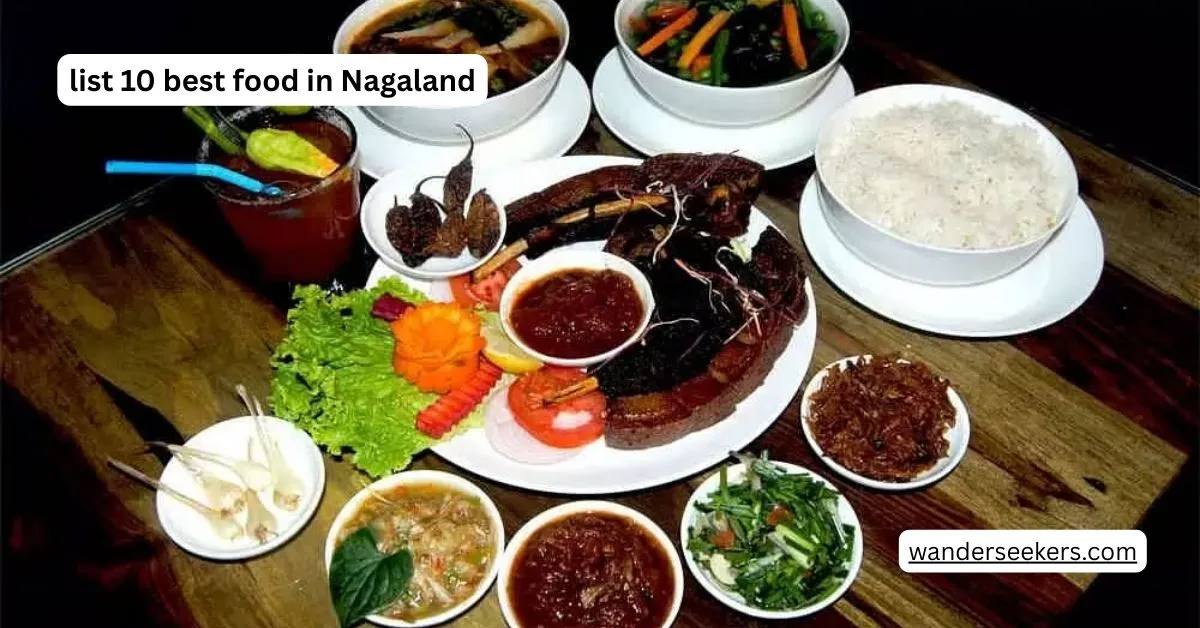Nagaland’s cuisine is deeply rooted in its tribal traditions, offering bold flavors and unique ingredients. One of the most famous dishes is Smoked Pork with Bamboo Shoot, where pork is slow-cooked with bamboo shoots, giving it a tangy and earthy taste. Galho, often compared to khichdi, is a comforting one-pot meal made with rice, vegetables, and sometimes meat, flavored with local herbs. Hinkejvu is a simple yet delicious dish made with colocasia, cabbage, and mustard leaves, cooked together until soft. Axone (Fermented Soybean) is a staple ingredient in Naga cuisine, used in stews, curries, and chutneys, adding a distinct pungent aroma. Bamboo Shoot Curry is another popular dish, where fresh bamboo shoots are cooked with meat or fish, creating a tangy and aromatic meal. Zutho, a traditional rice beer, holds cultural significance and is enjoyed during festivals and social gatherings. Samathu is a spicy pork curry made with fermented soybean and smoked meat, offering a rich and robust flavor. Black Sticky Rice Pudding, a sweet dish made from black sticky rice, coconut milk, and sugar, is both delicious and nutritious. Aikibeye, a simple dish made with mustard greens and colocasia, is a perfect accompaniment to spicy meals. Fish Tenga, a light and tangy fish curry, is flavored with tomatoes and bamboo shoots, making it a refreshing dish. These dishes showcase the diversity and richness of Naga cuisine, offering a delightful culinary experience for food lovers.
Table of Contents
1. Smoked Pork with Bamboo Shoot
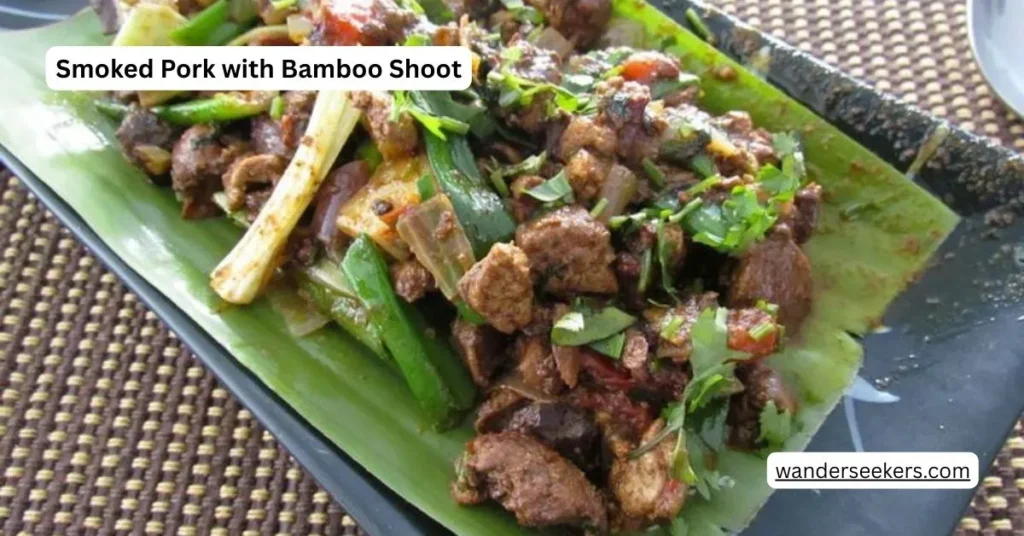
Smoked Pork with Bamboo Shoot is a flavorful dish popular in Northeast India, particularly in Nagaland and Meghalaya. The dish features smoked pork, which is slow-cooked to enhance its rich, deep flavors, paired with bamboo shoots, adding a slightly tangy and earthy contrast. To prepare, the pork is first smoked over an open flame or dried, intensifying its taste. It is then simmered with bamboo shoots, green chilies, garlic, ginger, and minimal spices, allowing the natural flavors to shine. Some variations include fermented soybeans or axone (fermented soybean paste), adding more depth.
2. Galho
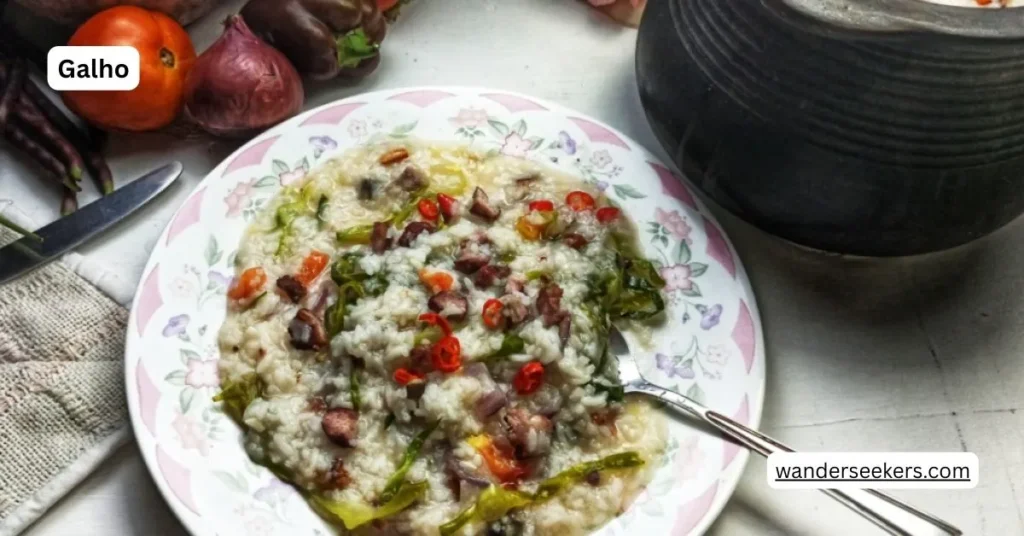
Galho is a comforting one-pot rice dish from Nagaland, closely resembling khichdi but infused with rich, smoky flavors. Traditionally made with rice, vegetables, and smoked or fermented meat, it is a staple in Naga households, celebrated for its simplicity and warmth. The dish is slow-cooked with ingredients like mustard leaves, ginger, garlic, green chilies, and fermented soybeans (Axone) for an extra depth of umami. Some variations include adding dried or smoked fish for a distinct flavor. The consistency can be thick or soupy, depending on preference. Galho is typically enjoyed piping hot, making it perfect for cold weather. It is often paired with a side of pickles or roasted meat, enhancing its rustic taste.
3. Hinkejvu
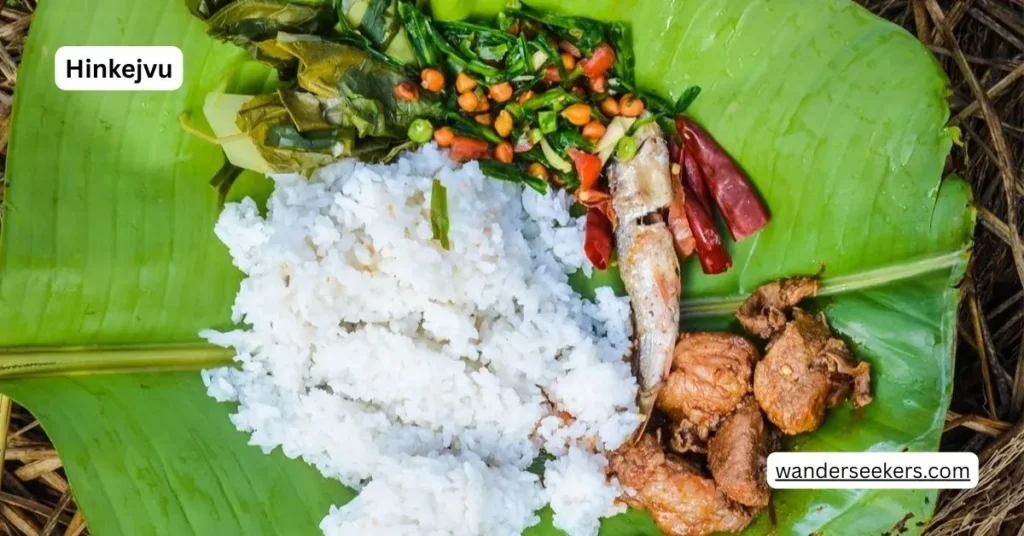
Hinkejvu is a classic Naga dish, celebrated for its simplicity and nourishing qualities. It is prepared by boiling leafy greens such as mustard leaves, cabbage, or colocasia with minimal seasoning, ensuring the natural flavors of the vegetables remain intact. The dish is light, wholesome, and easy to digest, making it a staple in Naga households. Traditionally, Hinkejvu is made with just salt and water, though some versions include fermented soybean (Axone) or garlic to enhance the umami taste. Occasionally, small pieces of meat or dried fish are added for additional richness. The slow cooking process preserves the vegetables’ nutrition, making the dish both hearty and healthy.
4. Axone (Fermented Soybean)

Axone, also known as fermented soybean, is a key ingredient in Naga cuisine, valued for its strong aroma and rich umami taste. Prepared by fermenting soybeans under specific conditions, Axone develops a deep, earthy flavor that enhances various traditional dishes. Its intense aroma might be unfamiliar to some, but for the Naga people, it is an essential element in cooking. Axone is often used in curries, stews, chutneys, and even mixed with meats or vegetables to bring out bold flavors. It pairs exceptionally well with smoked pork, dried fish, and bamboo shoots, making dishes more complex and flavorful. Beyond its culinary use, Axone is high in protein and beneficial for digestion.
5. Bamboo Shoot Curry

Bamboo Shoot Curry is a flavorful and aromatic dish widely enjoyed across Northeast India, particularly in Nagaland and Assam. The dish highlights the unique, slightly tangy taste of fresh or fermented bamboo shoots, which pair beautifully with a variety of ingredients such as pork, chicken, or vegetables. To prepare, bamboo shoots are first boiled to reduce their natural bitterness. They are then slow-cooked with garlic, ginger, onions, and a blend of spices like turmeric and chilies, creating a rich and mildly spiced gravy. Some variations include adding fermented soybean (Axone) or mustard oil for extra depth and flavor. Served with steamed rice, Bamboo Shoot Curry is appreciated for its bold, earthy taste and soft texture.
6. Zutho

Zutho is a traditional fermented rice beer from Nagaland, deeply rooted in the Ao Naga community’s culinary and social traditions. It is made by fermenting cooked rice with natural yeast, resulting in a mildly alcoholic beverage with a slightly sour and refreshing taste. The fermentation process gives Zutho its distinct cloudy appearance and tangy flavor, which varies depending on the fermentation duration. Some versions are stronger in alcohol content, while others are light and mildly sweet. It is often consumed during festive gatherings, cultural celebrations, and social events, bringing people together in communal settings.
7. Samathu
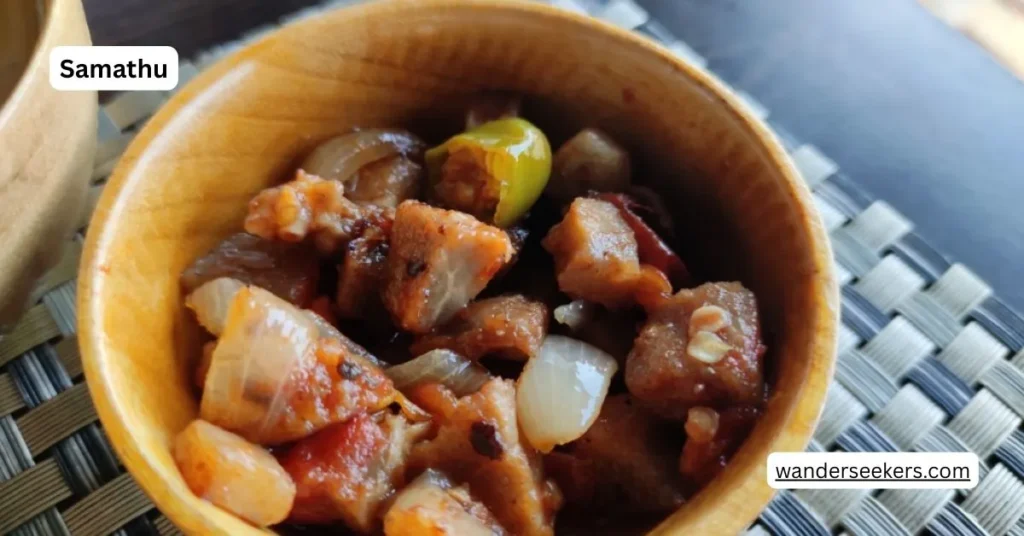
Samathu is a traditional smoky pork curry from Nagaland, loved for its rich, deep flavors. Made with fermented soybean (Axone) and smoked pork, this dish captures the essence of Naga cuisine—bold, earthy, and packed with umami. The pork is first smoked to intensify its taste and texture, then slow-cooked with fermented Axone, green chilies, ginger, and garlic. Some variations include bamboo shoots or dried fish, adding extra layers of flavor. The dish is minimally spiced, allowing the natural smokiness and fermentation to shine. Samathu is best enjoyed with steamed rice, as its savory, slightly tangy taste pairs well with the neutral grain.
8. Black Sticky Rice Pudding

Black Sticky Rice Pudding is a rich and aromatic dessert popular in Southeast Asian cuisine, especially in Thailand and Indonesia. It is made using black glutinous rice, which is slowly cooked with coconut milk and sugar, resulting in a creamy, slightly chewy texture. The natural nutty flavor and deep purple hue of the rice make this pudding visually appealing and uniquely delicious. Some variations include pandan leaves for fragrance or a topping of coconut cream for extra richness. The dish is naturally gluten-free and packed with antioxidants, making it a wholesome treat. Often served warm or chilled, Black Sticky Rice Pudding is enjoyed as a comforting dessert or snack.
9. Aikibeye
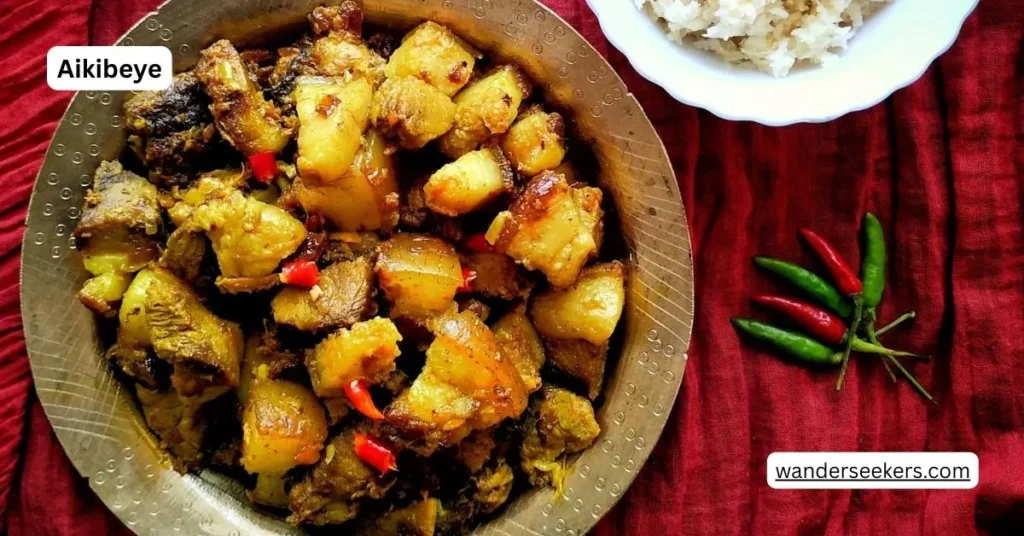
Aikibeye is a comforting dish from Arunachal Pradesh, particularly popular among the Adi tribe. It is a simple yet delicious preparation made using rice, vegetables, and perilla seeds, which impart a unique nutty flavor. The dish is cooked by boiling rice along with locally available vegetables like mustard greens or pumpkin. The highlight of Aikibeye is the use of perilla seeds, which are roasted and ground into a paste before being added to the dish. These seeds enhance the flavor and provide a rich, slightly earthy taste. Some variations include adding smoked meat or fermented ingredients for depth. Served warm, Aikibeye is known for its wholesome and light taste, making it a nutritious meal choice.
10. Bushmeat Dishes
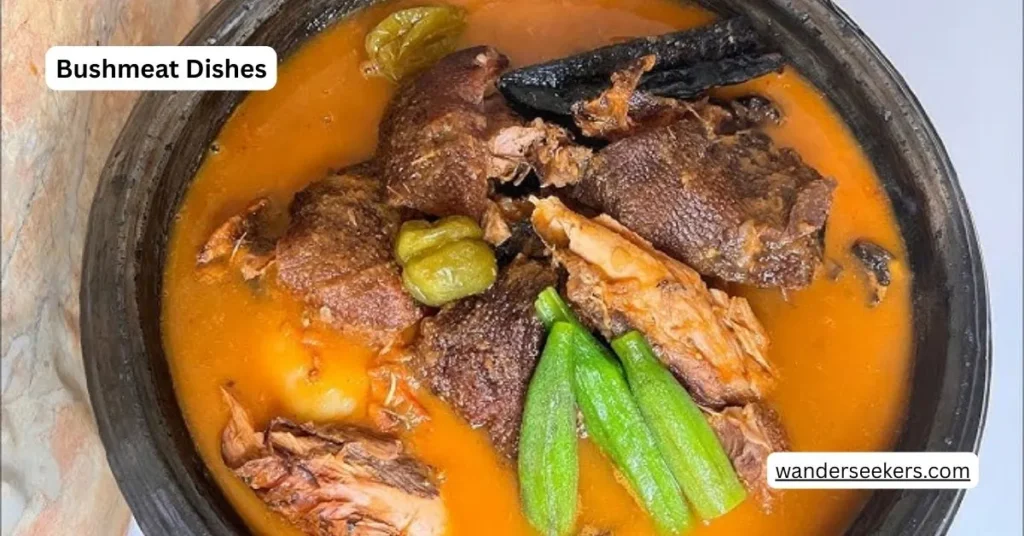
Bushmeat dishes are traditional preparations featuring meat sourced from wild animals, commonly consumed in parts of Africa, South America, and Southeast Asia. These dishes often include game like deer, wild boar, porcupine, monitor lizard, or bush rats, cooked with local spices and herbs to enhance their flavors. The cooking methods vary by region—smoking, grilling, stewing, or frying—to bring out the unique taste and texture of each meat. In many communities, bushmeat is a cultural delicacy, associated with festive occasions and ancestral traditions. Ingredients like palm oil, chili, garlic, ginger, and fermented sauces are often used to complement the meat’s bold flavors. However, concerns about conservation and health risks have led to discussions about responsible sourcing and alternatives.
